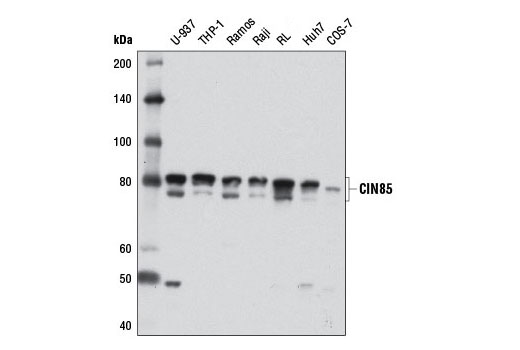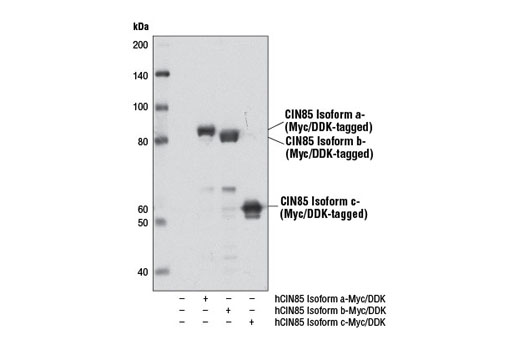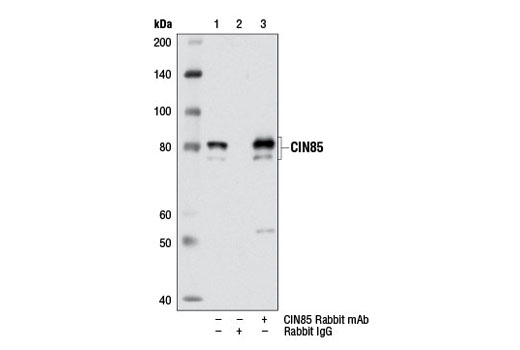WB, IP
H M Mk
Endogenous
78, 82
Rabbit IgG
#Q96B97
30011
Product Information
Product Usage Information
| Application | Dilution |
|---|---|
| Western Blotting | 1:1000 |
| Immunoprecipitation | 1:200 |
Storage
Specificity / Sensitivity
Species Reactivity:
Human, Mouse, Monkey
Species predicted to react based on 100% sequence homology
The antigen sequence used to produce this antibody shares
100% sequence homology with the species listed here, but
reactivity has not been tested or confirmed to work by CST.
Use of this product with these species is not covered under
our
Product Performance Guarantee.
Rat, Hamster, Bovine, Dog, Pig
Source / Purification
Monoclonal antibody is produced by immunizing animals with a synthetic peptide corresponding to residues surrounding Lys485 of human CIN85 protein.
Background
CIN85 was independently identified as Cbl-interacting protein of 85 kDa (1), Ruk (regulator of ubiquitous kinase) (2), SETA (SH3 domain-containing gene expressed in tumorigenic astrocytes) (3), and SH3KBP1 (SH3 domain kinase binding protein 1) (4). The genes encoding these proteins were isolated from either human (CIN85), rat (Ruk and SETA), or mouse (SH3KBP1) sources and share between 92% and 97% sequence identity, suggesting that they represent homologues of one gene. Differential promoter usage and alternative splicing is thought to occur in a tissue specific and developmentally regulated manner to generate a complex expression pattern of various transcripts and encoded protein isoforms (5). The main isoform in humans, CIN85, contains three N-terminal SH3 domains, a proline-rich region harboring several P-X-X-P motifs that provide recognition sites for SH3 domain-containing proteins, a PEST sequence implicated in CIN85 degradation, and a C-terminal coiled-coil region for oligomerization (1,2,5,6). The other molecular variants of CIN85 are shorter, N-terminally truncated proteins lacking one, two, or all three of the SH3 domains (1,5,6-8). Proteomic screens suggest that CIN85 is phosphorylated at multiple sites and the role of phosphorylation of some of these sites in regulation of intra- and intermolecular interactions of CIN85 cannot be excluded. CIN85 belongs to the CD2AP/CMS family of adaptor proteins and has been shown to interact with signaling molecules such as c-Cbl, Cbl-b, BLNK, p85/PI3K, GRB2, p130 Cas, and endophilins to coordinate the activity of multiple signaling cascades. Indeed, a growing body of evidence suggests that CIN85 is required for the regulation of a variety of cellular processes including vesicle-mediated transport (9-12), signal transduction (13,14), and cytoskeleton remodelling (15).
- Take, H. et al. (2000) Biochem Biophys Res Commun 268, 321-8.
- Gout, I. et al. (2000) EMBO J 19, 4015-25.
- Borinstein, S.C. et al. (2000) Cell Signal 12, 769-79.
- Narita, T. et al. (2001) Cytogenet Cell Genet 93, 133-4.
- Buchman, V.L. et al. (2002) Gene 295, 13-17.
- Tibaldi, E.V. and Reinherz, E.L. (2003) Int Immunol 15, 313-29.
- Bögler, O. et al. (2000) Neuro Oncol 2, 6-15.
- Finniss, S. et al. (2004) Biochem Biophys Res Commun 325, 174-82.
- Havrylov, S. et al. (2008) Traffic 9, 798-812.
- Kowanetz, K. et al. (2004) Mol Biol Cell 15, 3155-66.
- Petrelli, A. et al. (2002) Nature 416, 187-90.
- Soubeyran, P. et al. (2002) Nature 416, 183-7.
- Borthwick, E.B. et al. (2004) J Mol Biol 343, 1135-46.
- Peruzzi, G. et al. (2007) J Immunol 179, 2089-96.
- Schmidt, M.H. et al. (2003) J Cell Sci 116, 2845-55.
Species Reactivity
Species reactivity is determined by testing in at least one approved application (e.g., western blot).
Western Blot Buffer
IMPORTANT: For western blots, incubate membrane with diluted primary antibody in 5% w/v nonfat dry milk, 1X TBS, 0.1% Tween® 20 at 4°C with gentle shaking, overnight.
Applications Key
WB: Western Blotting IP: Immunoprecipitation
Cross-Reactivity Key
H: human M: mouse R: rat Hm: hamster Mk: monkey Vir: virus Mi: mink C: chicken Dm: D. melanogaster X: Xenopus Z: zebrafish B: bovine Dg: dog Pg: pig Sc: S. cerevisiae Ce: C. elegans Hr: horse GP: Guinea Pig Rab: rabbit All: all species expected
Trademarks and Patents
使用に関する制限
法的な権限を与えられたCSTの担当者が署名した書面によって別途明示的に合意された場合を除き、 CST、その関連会社または代理店が提供する製品には以下の条件が適用されます。お客様が定める条件でここに定められた条件に含まれるものを超えるもの、 または、ここに定められた条件と異なるものは、法的な権限を与えられたCSTの担当者が別途書面にて受諾した場合を除き、拒絶され、 いかなる効力も効果も有しません。
研究専用 (For Research Use Only) またはこれに類似する表示がされた製品は、 いかなる目的についても FDA または外国もしくは国内のその他の規制機関により承認、認可または許可を受けていません。 お客様は製品を診断もしくは治療目的で使用してはならず、また、製品に表示された内容に違反する方法で使用してはなりません。 CST が販売または使用許諾する製品は、エンドユーザーであるお客様に対し、使途を研究および開発のみに限定して提供されるものです。 診断、予防もしくは治療目的で製品を使用することまたは製品を再販売 (単独であるか他の製品等の一部であるかを問いません) もしくはその他の商業的利用の目的で購入することについては、CST から別途許諾を得る必要があります。 お客様は以下の事項を遵守しなければなりません。(a) CST の製品 (単独であるか他の資材と一緒であるかを問いません) を販売、使用許諾、貸与、寄付もしくはその他の態様で第三者に譲渡したり使用させたりしてはなりません。また、商用の製品を製造するために CST の製品を使用してはなりません。(b) 複製、改変、リバースエンジニアリング、逆コンパイル、 分解または他の方法により製品の構造または技術を解明しようとしてはなりません。また、 CST の製品またはサービスと競合する製品またはサービスを開発する目的で CST の製品を使用してはなりません。(c) CST の製品の商標、商号、ロゴ、特許または著作権に関する通知または表示を除去したり改変したりしてはなりません。(d) CST の製品をCST 製品販売条件(CST’s Product Terms of Sale) および該当する書面のみに従って使用しなければなりません。(e) CST の製品に関連してお客様が使用する第三者の製品またはサービスに関する使用許諾条件、 サービス提供条件またはこれに類する合意事項を遵守しなければなりません。


